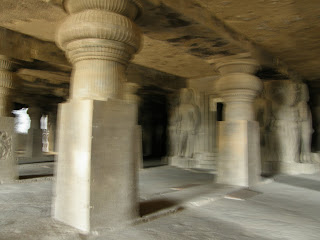


































Ajanta cave-temples
Maharashtra, India
The Buddhist cave temples of Ajanta were excavated from a horseshoe-shaped cliff, overlooking a bend of the Waghora river in northern Maharashtra, between the 2d century BC and the 5th century AD. The caves are numbered (1-28) according to their sequential location along the cliff face, which does not correspond to the order in which they were constructed.
The caves were used as a refuge by monks in the monsoon season, when the dry riverbed seen here would be filled with running water fed by a pool and waterfall, and the surrounding valley would be blanketed in lush, green vegetation. (This photograph was taken during the dry season, in February.)
Although both Hinayana and Mahayana phases of Buddhism are represented at Ajanta, the site is best known for its stunning Mahayana murals in caves 1, 2, 16, and 17. These 5th century murals are well-preserved, and completely accessible to visitors; their beauty and antiquity distinguish them as one of the treasures of Indian, and indeed world, art. Unfortunately, lighting conditions inside the caves were too dim to photograph the murals (see Behl for a fine selection), but the following pages sample the cave facades and sculptures.
No comments:
Post a Comment